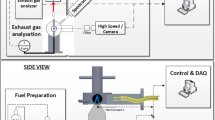Abstract
The present experimental study is performed to document the effects of carbon-to-hydrogen mass ratio (C/H) in liquid hydrocarbon fuels, on the luminosity, thermal radiation rate, and temperature of flame. Furthermore, extraction of the thermal and radiative characteristics of flame, and measurement of exhaust gases including CO, CO2, and NO x have been carried out. The CHNS elemental analyzer system was employed to ascertain fuel composition. The thermopile sensor and the lux meter were utilized to measure the flame thermal radiation and luminosity. The measured flame radiation spectrum included all possible wavelengths (i.e., flame thermal radiation) and visible wavelengths (i.e., luminosity). The flame photography technique, as a non-intrusive method, depicted the flame visible radiation, IR spectral emittance, and high temperature zone. The results revealed that the luminosity and thermal radiation of the flame increased as we increase C/H. A rise in C/H made the temperature along the flame axis more uniform. The NO x emissions were within standard levels (i.e., under 200 ppm). It was also shown that the C/H variation has a greater effect on luminosity than thermal radiation of the flame. The flame luminosity was increased by 66% when the C/H was increased from 5.47 to 5.68, whereas the flame thermal radiation increased by 26%. In addition, a new correlation is proposed to predict the linear relation of the increase in the thermal radiation and the increase in the luminosity of the flame as a function of C/H.









Similar content being viewed by others
References
Mensch A, Santoro RJ, Litzinger TA, Lee SY (2010) Sooting characteristics of surrogates for jet fuels. Combust Flame 157(6):1097–1105. doi:10.1016/j.combustflame.2010.02.008
Meng X, Xu C, Li L, Gao J (2011) Cracking performance and feed characterization study of catalytic pyrolysis for light olefin production. Energy Fuels 25(4):1357–1363. doi:10.1021/ef101775x
Yue L, Li G, He G, Guo Y, Xu L, Fang W (2016) Impacts of hydrogen to carbon ratio (H/C) on fundamental properties and supercritical cracking performance of hydrocarbon fuels. Chem Eng J 283:1216–1223. doi:10.1016/j.cej.2015.08.081
Zhang L, Li S, Han L, Sun X, Xu Z, Shi Q, Xu C, Zhao S (2013) Coking reactivity of laboratory-scale unit for two heavy petroleum and their supercritical fluid extraction subfractions. Ind Eng Chem Res 52(16):5593–5600. doi:10.1021/ie302891b
Sforzo B, Dao H, Wei S, Seitzman J (2016) Liquid fuel composition effects on forced, nonpremixed ignition. J Eng Gas Turbines Power 139(3):031509-031509-031508. doi:10.1115/1.4034502
Attaphong C, Singh V, Balakrishnan A, Do LD, Arpornpong N, Parthasarathy RN, Gollahalli SR, Khaodhiar S, Sabatini DA (2016) Phase behaviors, fuel properties, and combustion characteristics of alcohol-vegetable oil-diesel microemulsion fuels. Int J Green Energy 13(9):930–943. doi:10.1080/15435075.2015.1088854
Köylü UO, Faeth GM (1993) Radiative properties of flame-generated soot. J Heat Transf 115(2):409–417. doi:10.1115/1.2910693
Javadi SM, Moghiman M (2012) Experimental study of natural gas temperature effects on the flame luminosity and no emission. Int J Spray Combust Dyn 4(2):175–184. doi:10.1260/1756-8277.4.2.175
Pourhoseini SH, Moghiman M (2015) Effect of pulverized anthracite coal particles injection on thermal and radiative characteristics of natural gas flame: an experimental study. Fuel 140:44–49. doi:10.1016/j.fuel.2014.09.056
Balakrishnan A, Parthasarathy RN, Gollahalli SR (2015) Combustion characteristics of partially premixed prevaporized palm methyl ester and jet a fuel blends. J Energy Res Technol 138(1):012202. doi:10.1115/1.4031966
Koseki H (1989) Combustion properties of large liquid pool fires. Fire Technol 25(3):241–255. doi:10.1007/BF01039781
Love ND, Parthasarathy RN, Gollahalli SR (2009) Rapid characterization of radiation and pollutant emissions of biodiesel and hydrocarbon liquid fuels. J Energy Res Technol 131(1):012202. doi:10.1115/1.3068345
Tran V, Morton C, Parthasarathy RN, Gollahalli SR (2014) Pool fires of biofuels and their blends with petroleum diesel. Int J Green Energy 11(6):595–610. doi:10.1080/15435075.2013.787426
Dhamale N, Parthasarathy RN, Gollahalli SR (2011) Effects of turbulence on the combustion properties of partially premixed flames of canola methyl ester and diesel blends. J Combust 2011:1–13. doi:10.1155/2011/697805
Li Y-H, Wu C-Y, Lien Y-S, Chao Y-C (2010) Development of a high-flame-luminosity thermophotovoltaic power system. Chem Eng J 162(1):307–313. doi:10.1016/j.cej.2010.04.051
Thornock J, Tovar D, Tree DR, Xue Y, Tsiava R (2015) Radiative intensity, no emissions, and burnout for oxygen enriched biomass combustion. Proc Combust Inst 35(3):2777–2784. doi:10.1016/j.proci.2014.06.148
Mungekar HP, Atreya A (2006) Flame radiation and soot emission from partially premixed methane counterflow flames. J Heat Transf 128(4):361. doi:10.1115/1.2165204
Augustine C, Tester JW (2009) Hydrothermal flames: from phenomenological experimental demonstrations to quantitative understanding. J Supercrit Fluids 47(3):415–430. doi:10.1016/j.supflu.2008.10.003
Pourhoseini SH, Moghiman M (2014) Experimental and numerical investigation into enhancing radiation characteristics of natural-gas flame by injection of micro kerosene droplets. J Enhanc Heat Transf 21(6):407–423. doi:10.1615/JEnhHeatTransf.2015011735
Bressloff NW, Moss JB, Rubini PA (1997) Differential total absorptivity solution to the radiative transfer equation for mixtures of combustion gases and soot. Numer Heat Transf Part B Fundam 31(1):43–60. doi:10.1080/10407799708915098
Saji CB, Balaji C, Sundararajan T (2008) Investigation of soot transport and radiative heat transfer in an ethylene jet diffusion flame. Int J Heat Mass Transf 51(17–18):4287–4299. doi:10.1016/j.ijheatmasstransfer.2008.02.010
Paul SC, Paul MC (2010) Radiative heat transfer during turbulent combustion process. Int Commun Heat Mass Transf 37(1):1–6. doi:10.1016/j.icheatmasstransfer.2009.10.005
Kumar P (2012) An experimental and numerical study of NO x formation mechanisms in NH3-H2-Air flames. Graduate Theses and Dissertations. Iowa State University. Paper 12821. http://lib.dr.iastate.edu/etd/12821
Lee JCY, Malte PC, Benjamin MA (2003) Low NO x combustion for liquid fuels: atmospheric pressure experiments using a staged prevaporizer-premixer. J Eng Gas Turbines Power 125(4):861–871. doi:10.1115/1.1584476
Author information
Authors and Affiliations
Corresponding author
Additional information
Technical Editor: Fernando Marcelo Pereira.
Rights and permissions
About this article
Cite this article
Boghrati, M., Moghiman, M. & Pourhoseini, S.H. The impact of C/H on the radiative and thermal behavior of liquid fuel flames and pollutant emissions. J Braz. Soc. Mech. Sci. Eng. 39, 2395–2403 (2017). https://doi.org/10.1007/s40430-017-0808-7
Received:
Accepted:
Published:
Issue Date:
DOI: https://doi.org/10.1007/s40430-017-0808-7




